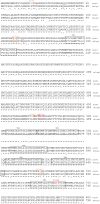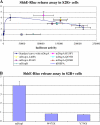Truncating loss-of-function mutations of DISP1 contribute to holoprosencephaly-like microform features in humans
- PMID: 19184110
- PMCID: PMC2774849
- DOI: 10.1007/s00439-009-0628-7
Truncating loss-of-function mutations of DISP1 contribute to holoprosencephaly-like microform features in humans
Abstract
Defective function of the Sonic Hedgehog (SHH) signaling pathway is the most frequent alteration underlying holoprosencephaly (HPE) or its various clinical microforms. We performed an extensive mutational analysis of the entire human DISP1 gene, required for secretion of all hedgehog ligand(s) and which maps to the HPE 10 locus of human chromosome 1q41, as a HPE candidate gene. Here, we describe two independent families with truncating mutations in human DISP1 that resemble the cardinal craniofacial and neuro-developmental features of a recently described microdeletion syndrome that includes this gene; therefore, we suggest that DISP1 function contributes substantially to both of these signs in humans. While these clinical features are consistent with common HPE microforms, especially those linked to defective signaling by Sonic Hedgehog, we have insufficient evidence so far that functionally abnormal DISP1 alleles will commonly contribute to the more severe features of typical HPE.
Figures



Similar articles
-
DISP1 deficiency: Monoallelic and biallelic variants cause a spectrum of midline craniofacial malformations.Genet Med. 2024 Jul;26(7):101126. doi: 10.1016/j.gim.2024.101126. Epub 2024 Mar 24. Genet Med. 2024. PMID: 38529886
-
Rescue of holoprosencephaly in fetal alcohol-exposed Cdon mutant mice by reduced gene dosage of Ptch1.PLoS One. 2013 Nov 11;8(11):e79269. doi: 10.1371/journal.pone.0079269. eCollection 2013. PLoS One. 2013. PMID: 24244464 Free PMC article.
-
Mutations in Hedgehog acyltransferase (Hhat) perturb Hedgehog signaling, resulting in severe acrania-holoprosencephaly-agnathia craniofacial defects.PLoS Genet. 2012;8(10):e1002927. doi: 10.1371/journal.pgen.1002927. Epub 2012 Oct 4. PLoS Genet. 2012. PMID: 23055936 Free PMC article.
-
Holoprosencephaly: from Homer to Hedgehog.Clin Genet. 1998 Mar;53(3):155-63. doi: 10.1111/j.1399-0004.1998.tb02666.x. Clin Genet. 1998. PMID: 9630065 Review.
-
Mutations in holoprosencephaly.Hum Mutat. 2000;16(2):99-108. doi: 10.1002/1098-1004(200008)16:2<99::AID-HUMU2>3.0.CO;2-0. Hum Mutat. 2000. PMID: 10923031 Review.
Cited by
-
Analysis of genotype-phenotype correlations in human holoprosencephaly.Am J Med Genet C Semin Med Genet. 2010 Feb 15;154C(1):133-41. doi: 10.1002/ajmg.c.30240. Am J Med Genet C Semin Med Genet. 2010. PMID: 20104608 Free PMC article. Review.
-
Dosage analysis of the 7q11.23 Williams region identifies BAZ1B as a major human gene patterning the modern human face and underlying self-domestication.Sci Adv. 2019 Dec 4;5(12):eaaw7908. doi: 10.1126/sciadv.aaw7908. eCollection 2019 Dec. Sci Adv. 2019. PMID: 31840056 Free PMC article.
-
Sonic hedgehog signaling in craniofacial development.Differentiation. 2023 Sep-Oct;133:60-76. doi: 10.1016/j.diff.2023.07.002. Epub 2023 Jul 13. Differentiation. 2023. PMID: 37481904 Free PMC article. Review.
-
In-depth investigations of adolescents and adults with holoprosencephaly identify unique characteristics.Genet Med. 2018 Jan;20(1):14-23. doi: 10.1038/gim.2017.68. Epub 2017 Jun 22. Genet Med. 2018. PMID: 28640243 Free PMC article.
-
The unfolding clinical spectrum of holoprosencephaly due to mutations in SHH, ZIC2, SIX3 and TGIF genes.Eur J Hum Genet. 2010 Sep;18(9):999-1005. doi: 10.1038/ejhg.2010.70. Epub 2010 Jun 9. Eur J Hum Genet. 2010. PMID: 20531442 Free PMC article.
References
-
- Bendavid C, Haddad BR, Griffin A, Huizing M, Dubourg C, Gicquel I, Cavalli LR, Pasquier L, Long R, Ouspenskaia MV, Odent S, Lacbawan F, David V, Muenke M. Multicolor FISH and quantitative PCR can detect submicroscopic deletions in holoprosencephaly patients with a normal karyotype. J Med Genet. 2005a;43:496–500. - PMC - PubMed
-
- Bendavid C, Dubourg C, Gicquel I, Pasquier L, Saugler-Veber P, Durou M-R, Jaillard S, Frebourg T, Haddad BR, Henry C, Odent S, David V. Molecular evaluation of foetuses with holoprosencephaly shows high incidence of microdeletions in the HPE genes. Hum Genet. 2005b;119:1–8. - PubMed
-
- Burke R, Nellen D, Bellotto M, Hafen E, Senti K-A, Dickson BJ, Basler K. Dispatched, a novel sterol-sensing domain protein dedicated to the release of cholesterol-modified hedgehog from signaling cells. Cell. 1999;99:803–815. - PubMed
-
- Caspary T, Garcia-Garcia MJ, Huangfu D, Eggenschwiler JT, Wyler MR, Rakeman AS, Alcorn HL, Anderson KV. Mouse Dispatched homolog1 is required for long-range, but not juxtacrine, Hh signaling. Cur Biol. 2002;12:1628–1632. - PubMed
-
- Cohen MM., Jr Holoprosencephaly: clinical, anatomic, and molecular dimension. Birth Defects Res Part A Clin Mol Teratol. 2006;76:658–673. - PubMed
Publication types
MeSH terms
Substances
Grants and funding
LinkOut - more resources
Full Text Sources
Molecular Biology Databases

